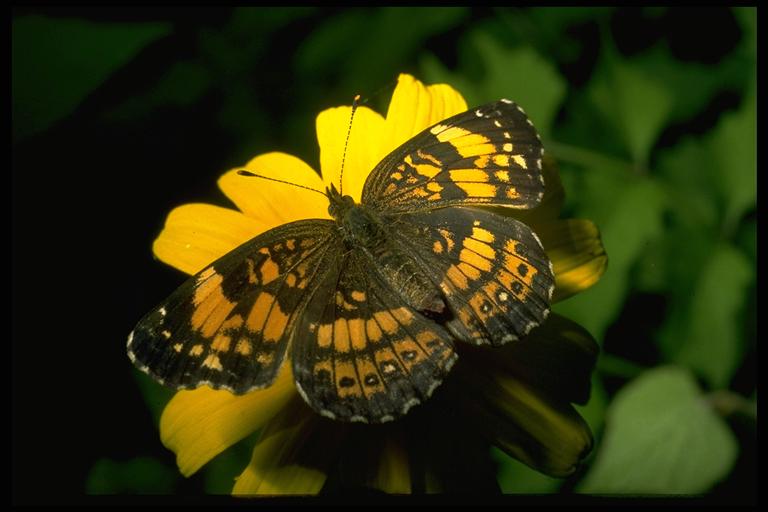
Pearl crescent, Phyciodes tharos (Drury) (Lepidoptera: Nymphalidae). Photo by Drees.
Common Name: Pearl crescent
Scientific Name: Phyciodes tharos (Drury)
Order: Lepidoptera
Description: This small to medium sized butterfly (1-1/4 to 1-1/2 inch wingspan) is overall orange with black markings, but is highly variable in its markings geographically and even from season to season.
The underside of the hindwings are relatively unmarked orange-brown to mottled gray-brown with a white crescent on the outer margin. A number of subspecies are recognized, including Phyciodes tharos distincta Bauer that also occurs in Texas south to Mexico. Caterpillars are blackish-brown with a cream-yellow stripe down their sides and blackish to yellowish branched spines covering their bodies.
A number of species closely resemble the pearl crescent and there are seven “crescent” species reported from Texas. The Texan crescent, Anthanassa texana Edwards, found commonly in the southern half of the state, is also small to medium sized (1-1/4 to 1-1/2 inch wingspan), but the upper wing surfaces are dark brown with orange markings at the bases and white spots forming bands on the wings and adorning the wing margins. Larvae feed on Acanthaceae.
The bordered patch, Chlosyne lacinia (Geyer), is one of eight closely related “patch” butterflies on the family, Nymphalidae, called the “brush-footed” butterflies. Also found in southern Texas, this species is highly variable but characteristically marked above with a wide curved yellow-orange band and small orange spots on a dark-brown background and with white dots along the wing margins. Larvae feed on a variety of Compositae including sunflowers and cocklebur. The Janais patch, Chlosyne janais (Drury), also occurs in south Texas, but has distinctive large red patches on the bases of the upper hind wing surfaces on otherwise black-brown wings and with front wings and wing margins marked with white spots.
Life Cycle: Adults lay eggs in clusters on host plants. Caterpillars hatching from eggs develop through several stages (instars) before forming a mottled grayish to brownish, spine-covered chrysalis. Up to five generations can be produced annually.
Habitat and Food Source(s): Caterpillars have chewing mouthparts. Adults have siphoning mouths. Caterpillars feed on leaves of asters and related Compositae. They feed together (gregarious) but do not spin silken webs.
Pest Status: Harmless.
For additional information, contact your local Texas A&M AgriLife Extension Service agent or search for other state Extension offices.
Literature: Howe 1975; Neck 1996; Wright 1993.